- 22 Minutes to read
- Print
- DarkLight
- PDF
MyPlan User Options
- 22 Minutes to read
- Print
- DarkLight
- PDF
Accessing MyPlan
How a user accesses MyPlan is based on user type; Contributor or MyPlan Only. The URL will be the same, but what each user sees when they login is based on the user and associated permissions. A Contributor user will have the ability to switch back and forth from the Planning application to MyPlan, while a MyPlan Only user will only have access to MyPlan. The example below describes the access for Contributor users.
From the Planful Planning application, click the person icon and then select Switch to MyPlan.
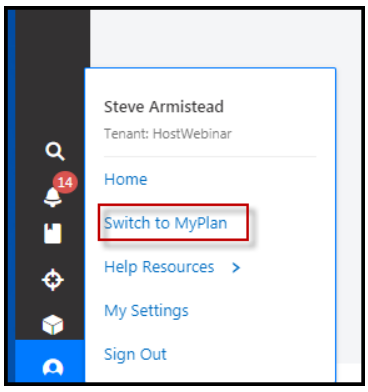
To return to the Planful Planning Module, click the initial icon in the upper right-hand corner of the screen (shown below) and select Switch to Contributor Mode.
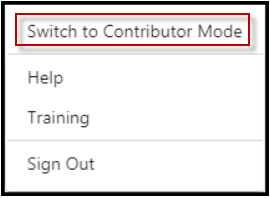
Dissecting the MyPlan Interface
MyPlan allows for the configuration of up to 3 panes as shown below. Each pane is independently configured by your administrator to display specific information in a particular format; Data or Chart. Your MyPlan interface may look different based on how your admin has configured it.
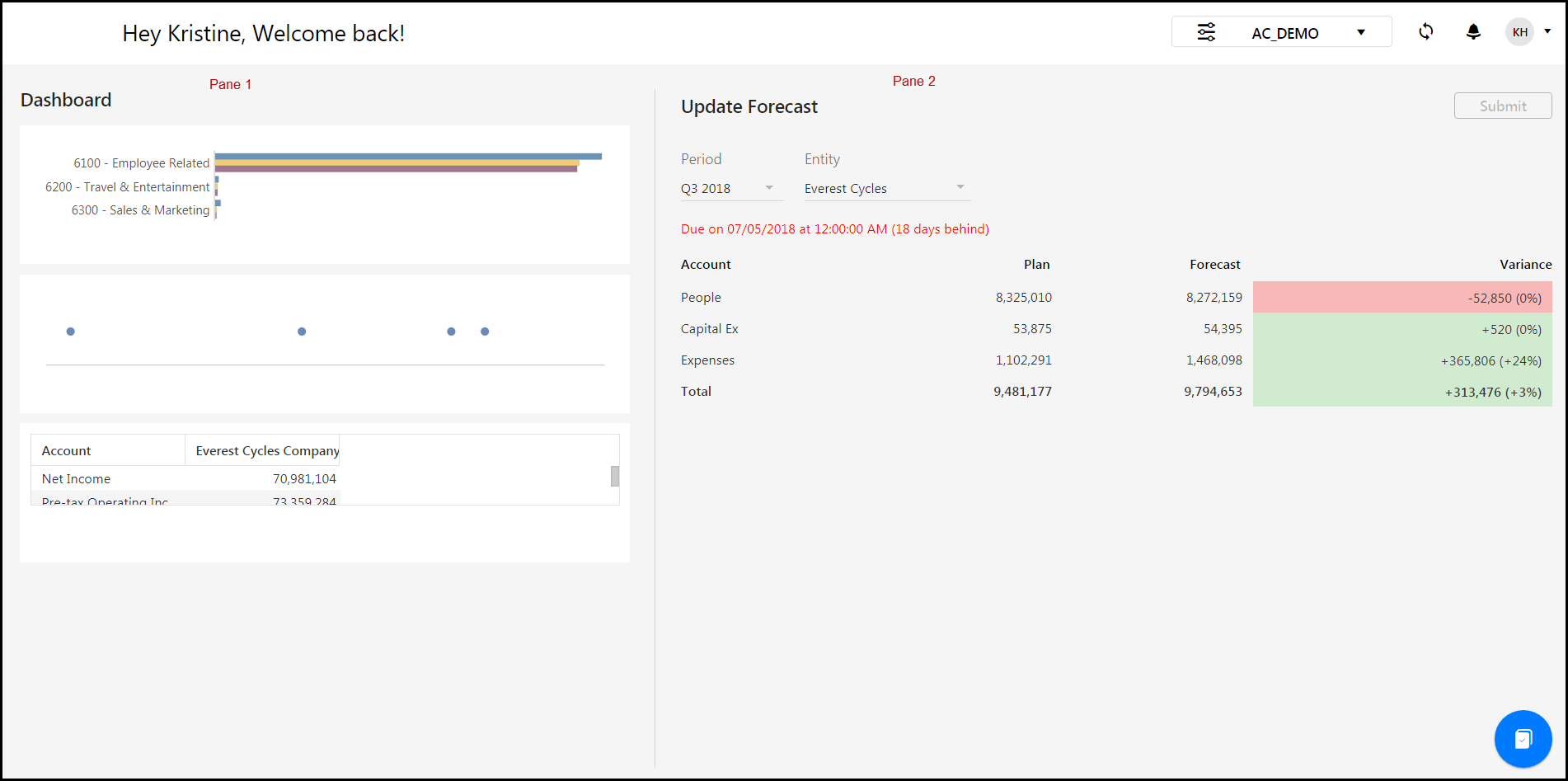
Charts Pane
In the example above, Pane 1 has been configured to display charts from the Dashboards application. Charts allow you to quickly evaluate how your organization is performing. For example, with charts you can visually compare your current budget with prior year actuals, see how your current headcount compares to a previous year, and view the variance between expenses and actuals.
Charts are interactive. You can hover over a chart to display information as shown below. And, you can filter members.
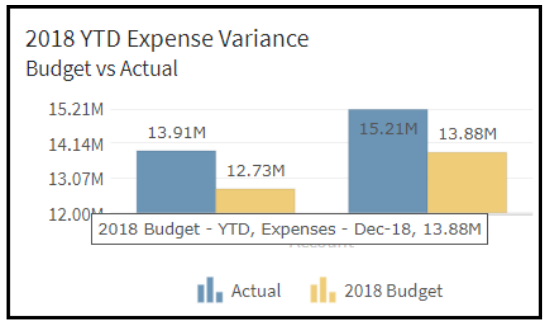
To filter members, select the member. For example, to filter 2018 Budget from the chart, click it. It will become greyed out and data will be filtered from the chart as shown below. To return the 2018 Budget data to the chart, click it again.
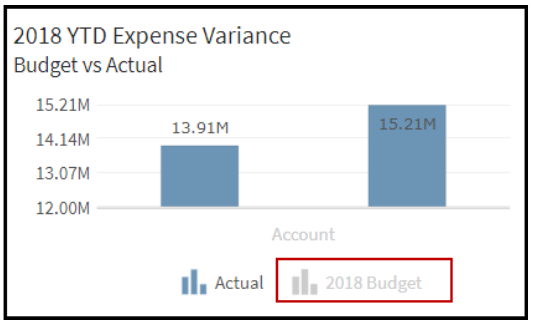
You cannot edit charts because they are sourced from the Dashboards application. To edit a chart, it must be done within Dashboards and you must be the owner of the chart or have appropriate privileges.
For information on editing charts in Dashboards, access the Dashboards End-User Guide.
Data Pane
In the example below, pane 2 is configured to display data. Templates are listed under the Account column. The 2nd column provides data from a scenario (such as a Forecast scenario) and the 3rd column provides Compare scenario data. For example, data from one scenario might be compared with actuals.
The Variance column is calculated by MyPlan and provides the difference between the Input Scenario column and the Compare scenario. MyPlan allows you to perform actions to help you solve variances. For example, let’s say you have a forecast and people costs are high as shown below.
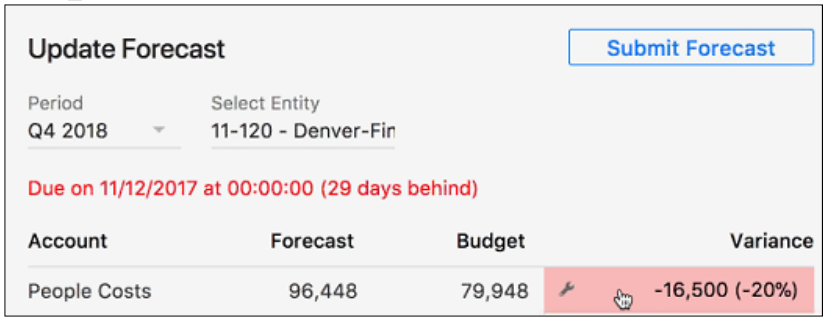
You’ve budgeted 79,948, but are forecasting you’ll need 96,448 due to a new headcount, which is planned to start in Q4 2018. The difference between these two numbers is provided in the Variance column. To get to a 0 variance, you might edit the new headcount position by changing the hire date to a later date within the quarter. Having the employee start at a later date means less people costs and a lower variance between budgeted and forecasted amounts.
There are many actions you can perform in Data type panes using the wrench icon. Each action is template specific. For example, you can add headcount to the Workforce Planning Module, but not to the Capital Module. Each action is discussed below.
Submit
When certain actions are performed, like adding a headcount or entering data within an input template, these actions are held in memory. That means they have not been committed to the database yet. When you are ready to store a change, click the Submit button. In the current version of MyPlan, this action does not trigger the planning workflow (this functionality is coming in the next release). So, an admin would have to manually forward the completed/submitted entries for approval. If a budget or forecast is not available for submission, the button will be disabled as shown below.

Period
Select a period from the list-box for which you want to view a plan / forecast.
Entity
Entities mapped to the scenario selected during configuration are listed here for selection.
Wrench
Click the Wrench icon to carry out tasks related to the template type, such as; update, adjust, and add. Tasks are specific to the template/module. For example, if you select a WFP account, the options are to Add New Headcount, Delete Headcount, or Edit Headcount. The wrench icon may not be available due to various reasons. For example, the forecast or budget may have been submitted or the entity may not be in a state where an update can be performed (for example, prior period data).
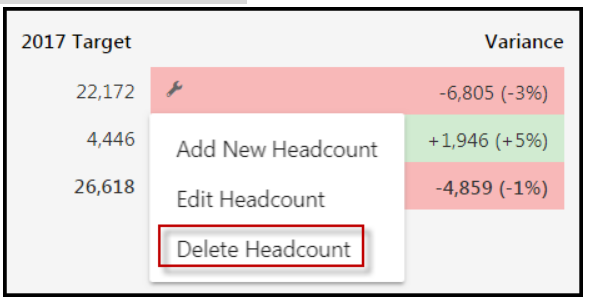
Similarly, if you select an expenses template, the option available is to adjust the accounts for that template.
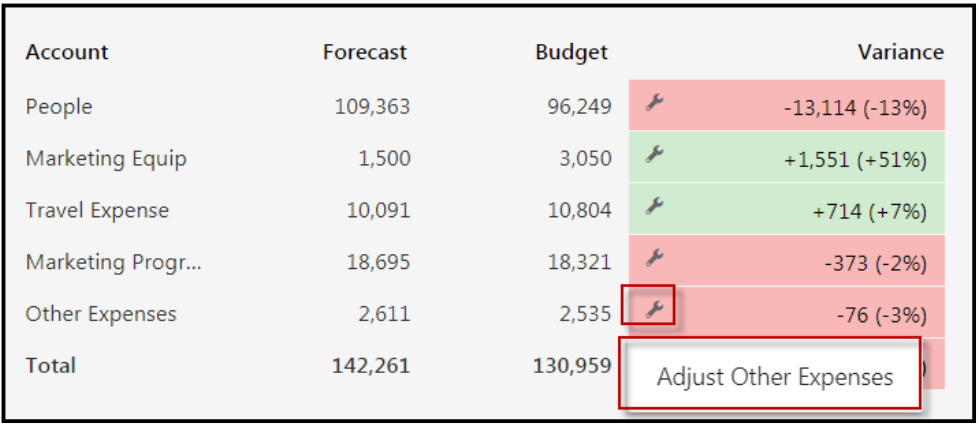
In the example below, the wrench for the Capital Planning module is selected.

Forward/Forward All/Show Data Trends
To the right of the Submit button are 3 three vertical dots . Click the dots to reveal the options:
Forward a budget or forecast for approval
Forward All - forward all members within a rollup (including the rollup member) for approval
Show Data Trends - Data Trends are setup by your Admin user so that you can view and compare prior, present or future data points to help complete a budget or forecast
When you select Show Data Trends , the reference scenario that your Admin user setup for each Compare Data element is displayed.
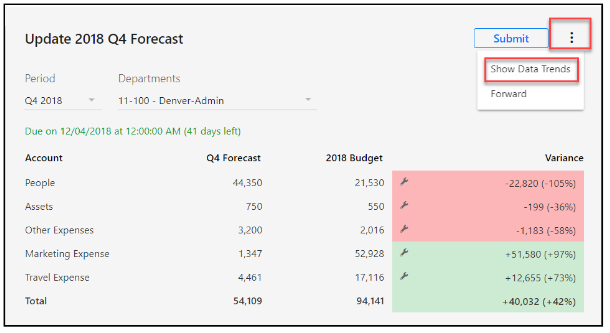
In the screen below, a Data Trend is shown. Select the Showing Data dropdown box to access Compare Data options.
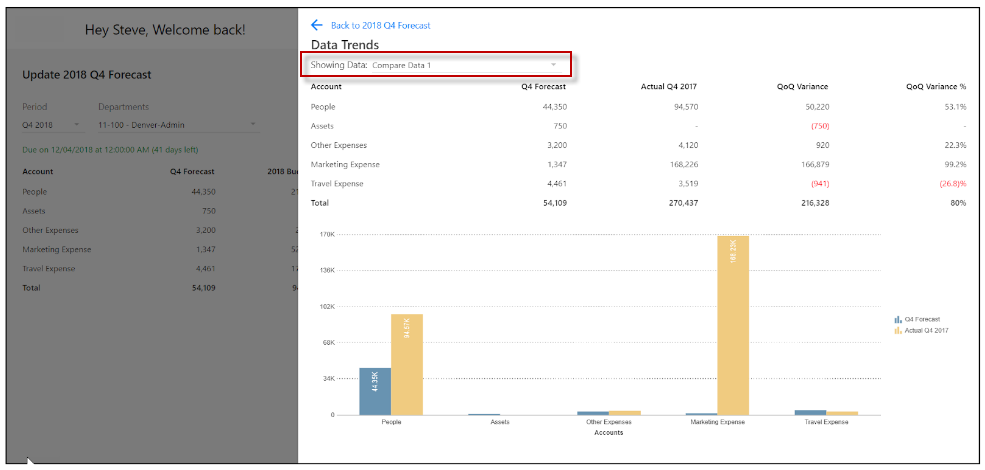
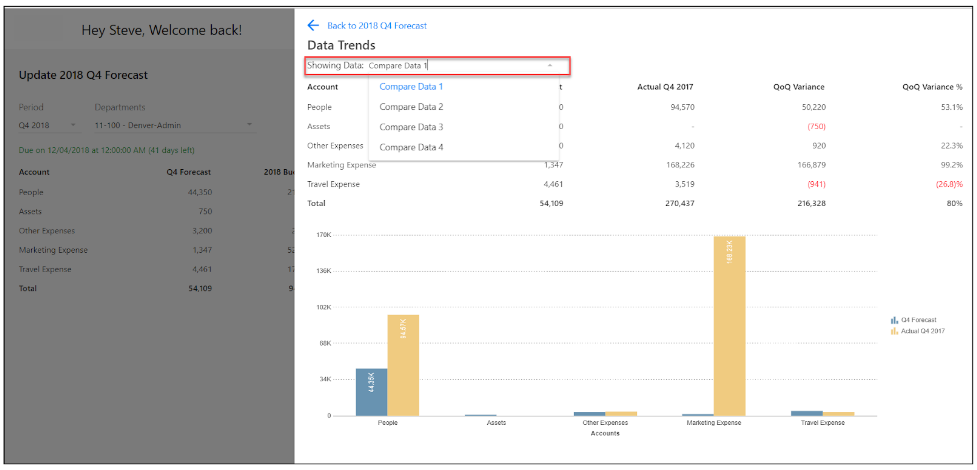
See Also:
How to Add an Asset Not Yet Budgeted
How to Add An Asset for a Budget Entity When the Asset Definition Does Not Exist
How to Adjust the Purchase Date of an Asset
Swamping Between Profiles
If your Admin user provides you with access to multiple MyPlan profiles, you will be able to swap back and forth between the profiles. In the image below, the profile list-box is shown.
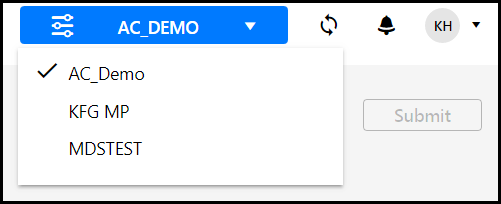
Refresh
Refresh functionality ensures that when the underlying data has changed from the planning side of the application, you have the latest data displayed in your MyPlan dashboard. Clicking the Refresh icon (shown below) allows the system to query and recalculate the most recent data, which may include changes to accounts or any underlying data directly connected with the information you are working with.
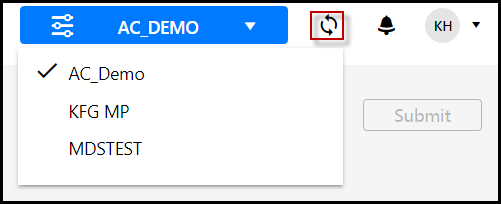
The Refresh icon is also available within each OPEX template opened in MyPlan as shown below.
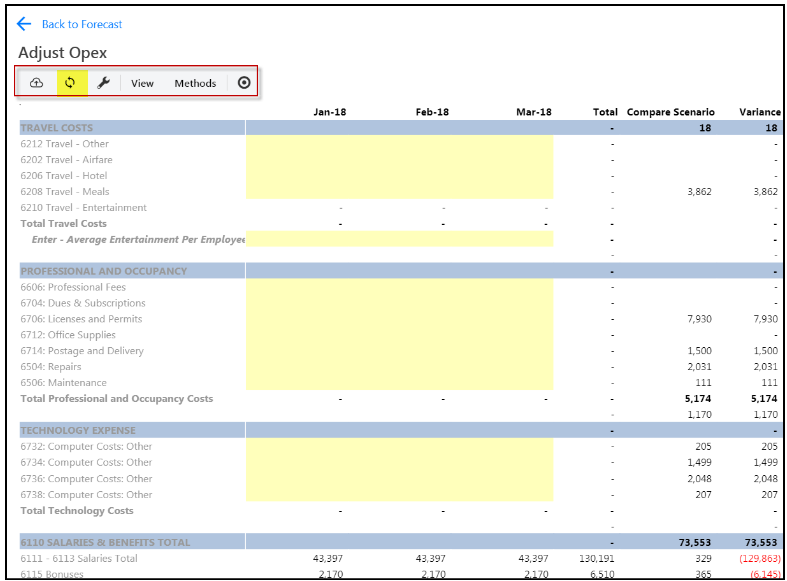
Notifications
Click the Notification icon to view information; such as when a template was forwarded for approval.
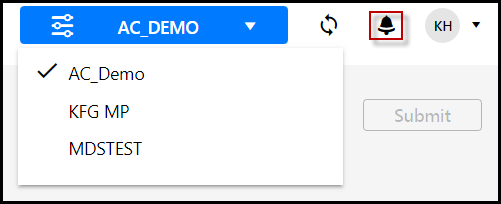
Retained In-Memory Actions
MyPlan offers Retained In-Memory Actions. With MyPlan, you can perform actions on your Budget or Forecast, take a break, and return (even a day later) to where you left off without having to continuously save. This is thanks to Retained In-Memory Actions functionality.
Additionally, if you are working on a budget entity, you can switch to another budget entity without having to submit actions performed on the former budget entity. The same goes for periods. When you change the period in MyPlan, navigate away from MyPlan, or logout, the data is not lost. Everything is retained in Activity Manager until you clear it.
How Actions Are Calculated
MyPlan calculates the impact of your actions for the entire scenario; not just the current year/period. For example, let's say you have a 2 year budget scenario (i.e. 2018-2019). Any modifications done to scenario data in MyPlan will be calculated for the entire 2 years on a period by period basis (i.e. monthly/quarterly).
For example, a user selects a 2018 period in the MyPlan dashboard and adds an employee named Wally Smith on September 3rd, 2018. The cost calculation will apply to both 2018 and 2019 instantly. Calculations are held in memory so that you can see all cost instantly and submit your actions. The impact to all years/periods of the scenario is displayed in Activity Manager as shown in the example below.
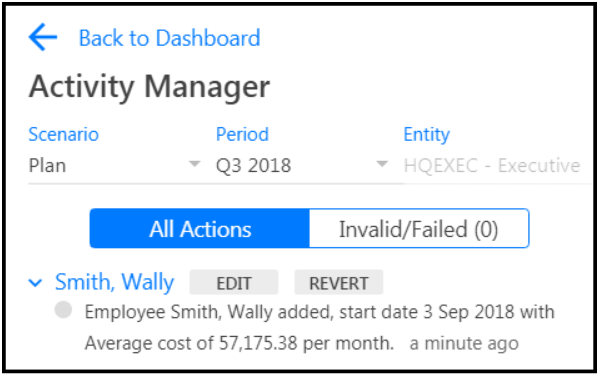
Now, let’s say an employee is added to a Q4 of 2018 Forecast scenario on November 1st of 2018. MyPlan will calculate the total compensation for the new employee for November and December of 2018 as well as the additional periods/years associated with the Forecast scenario.
Adjusting, Updating, Adding, and Editing Accounts in MyPlan
When you click the wrench icon, you can select to perform actions such as; adjust accounts, add to, or update related accounts. Updates are performed within the template, which is mapped to the entity (selected) and the mapped scenario. All actions are logged for auditing purposes and all actions are updated in the Planning application. Information on steps to perform specific actions is provided below.
How to Add New Headcount
Click the wrench icon for a WFP account and select Add New Headcount. A pane opens on the right-hand side of the screen as shown below.
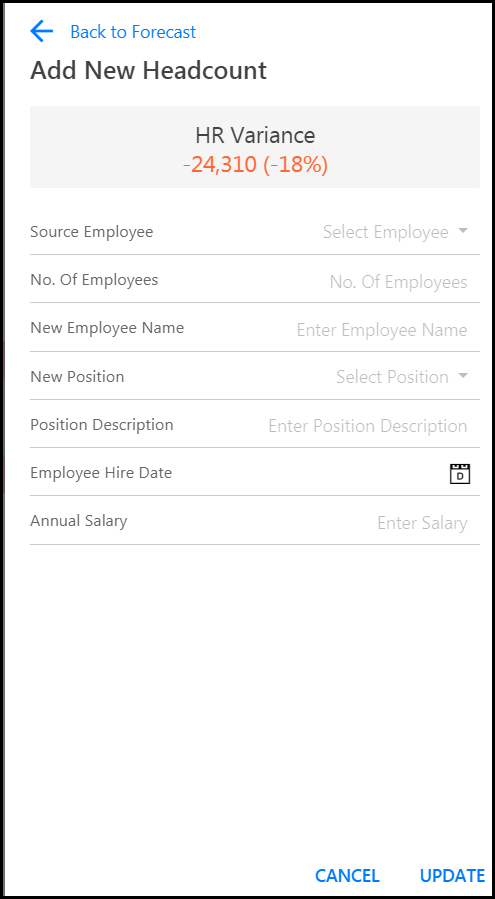
Select an employee that is similar to the employee you want to hire. The Source Employee is used to reference an existing employee’s non-essential information (such as bonus and medicare) from behind the scenes. This way, you (the user) does not have to complete all of these options to add a new headcount. The goal is to select an existing employee that closely mirrors the new headcount you would like to hire. All attributes for the source employee are copied to the new headcount you are adding.
Select the number of employees you want to add. In this case, it is only one, but you can add up to 10. See: Adding Multiple Employees.
Some attributes for the new employee are likely to be different from the source employee. One attribute is salary, which is why salary information displayed can be edited for the new (target) employee. Enter salary in the field.
Enter the employee’s name in the New Employee Name field.
Enter the employee’s job description in the Position Description field.
Click the Calendar icon and select the hire date for the new employee in the Employee Hire Date field. It is important that you do not add employees with a term date that is before the beginning of the scenario start date or where the start date is beyond the supported periods in your application.
Click UPDATE. Once you click UPDATE, information about the account will be updated. The impact on the account and the variance is displayed as shown below. Using the screenshot below as a reference, hiring Kristine (new employee) will result in a negative variance to the HR account and will have an impact to that account and forecast by an increase of 17,185 dollars.
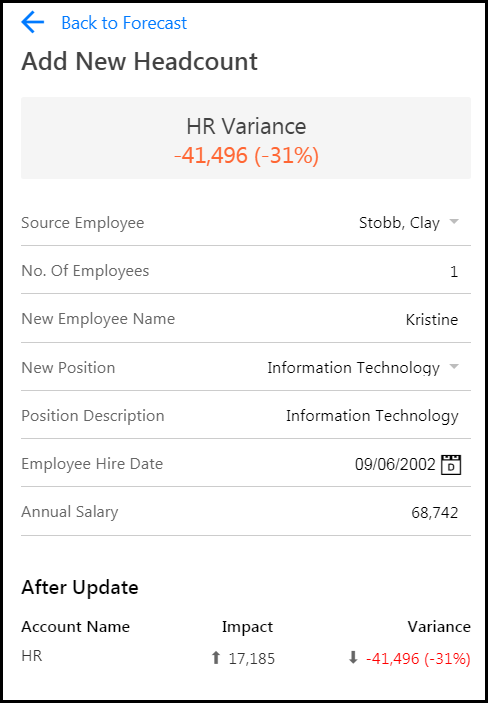
How to Edit a Headcount
Click the Wrench icon for a WFP account and select Edit Headcount. A pane opens on the right-hand side of the screen.
Select the employee you want to edit.
Modify the employee’s details; such as position, position description, employee hire date and employee termination date as needed. The impact (variance) of the modification is instantly displayed.
Click UPDATE.
How to Add Multiple Employees at Once
Add up to 10 employees at one time.
In Practice: Add Multiple Employees
Access the MyPlan dashboard.
For an HR account, click the Wrench icon.
Select Add New Headcount. The Add New Headcount pane appears.
Select the source employee as a base the new employee.
For No. Of Employees, enter any number up to 10. In the image below, 9 is entered.
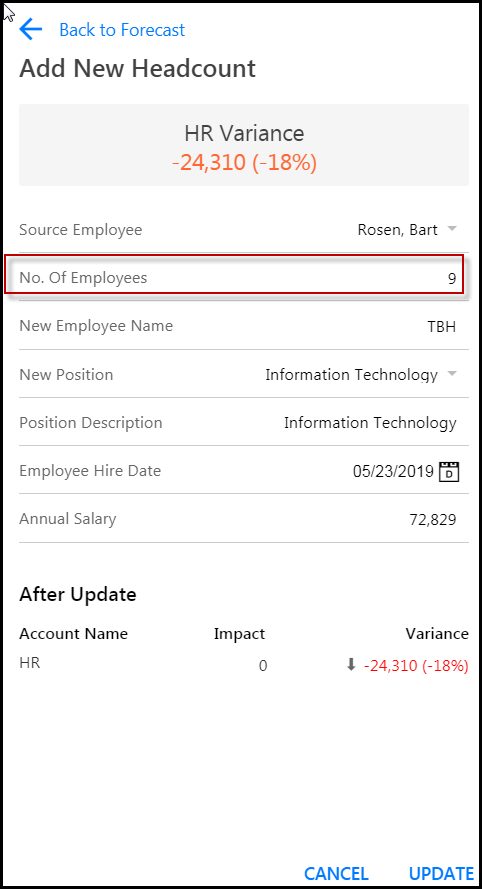
Enter a name (or placeholder name) for the new employees (It is best practice to use TBH for the name, you can always go back and edit each name later in you want, show below).). For this example, TBH was entered.
Click Update.
How to Edit Multiple New Hires at Once
Select the Wrench icon again and click Edit Headcount.
On the Edit Headcount pane, select any of the newly added TBH employees as shown below. Notice that additional headcount with the same name is appended with an underscore and the number.
Edit each of the 9 employees as needed and click Update.
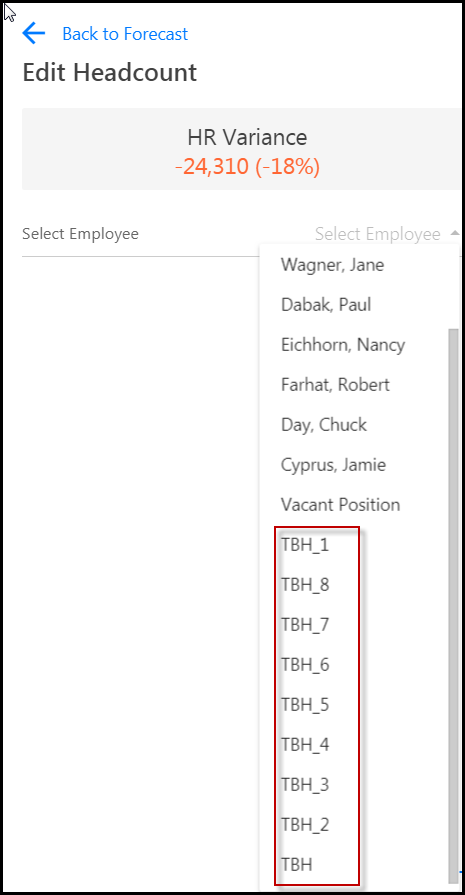
How to Add a Headcount Based on an Existing Headcount and Edit Details
Add a headcount based on an existing headcount and edit the headcount details. This functionality allows you to rapidly create and budget for headcount. Additionally, you can edit or revert the added headcount directly from Activity Manager.
In Practice
Start by simply adding a new headcount. In MyPlan, click the Wrench icon and select Add Headcount.
The Add New Headcount screen appears. For Source Employee, select an existing employee as a basis for the new headcount.
Change the New Employee Name to the name for the new headcount. In the image below, Brad Perlioni is the source employee and the new headcount is for CK Blevins.
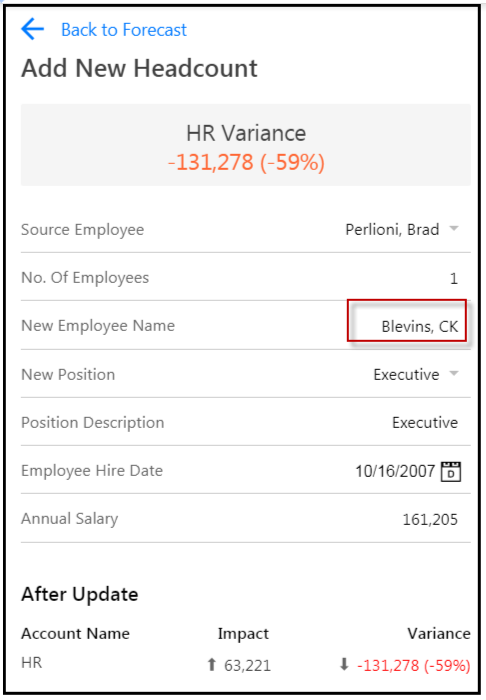
Adjust other parameters such as Salary and click Update.
Click the Activity Manager icon. The newly added headcount is shown. You can click Edit and the Edit Headcount screen will appear where you can further edit the headcount details, or, click Revert to reverse the addition of the headcount.
How to Edit the Employee Position Start Date
Edit the Employee Position Start Date for a more favorable variance. For example, let’s say you hire an employee on January 1st 2018 with a February 1st start date. However, the start date needs to be delayed until March 1st for a more favorable variance or because the employee needs to extend the start date. You can change the position start date for the employee in MyPlan without having to access Advanced Planning.
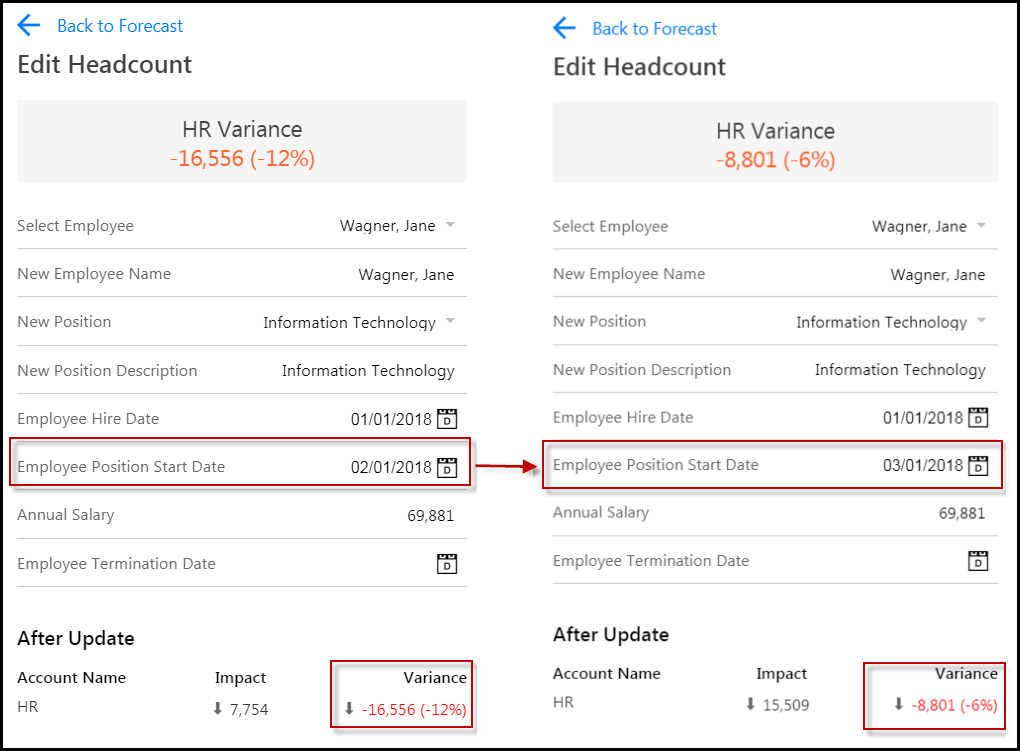
In Practice
In MyPlan, click the Wrench icon for an HR account and select Edit Headcount . The Edit Headcount page appears.
Edit the Employee Position Start Date as needed. As you change the start date, the variance is updated and displayed.
Once you have a favorable variance and selected the new start date, click Update.
How to Delete a Headcount
Delete headcount from the MyPlan interface. This is beneficial for MyPlan users to perform what-if analysis by adding headcount, checking variance, then deleting some of the newly added headcount to eventually reach target values/goals. This feature also allows MyPlan users to delete headcount without a need to access Planning in Contributor mode.
From the MyPlan interface, click the wrench icon as shown below for a Workforce account.
Select Delete Headcount.
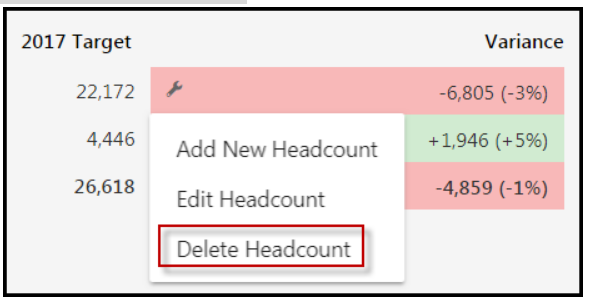
The Delete Headcount pane appears. Search for an employee by name or number. Type ahead functionality displays a list of available employees as you type.
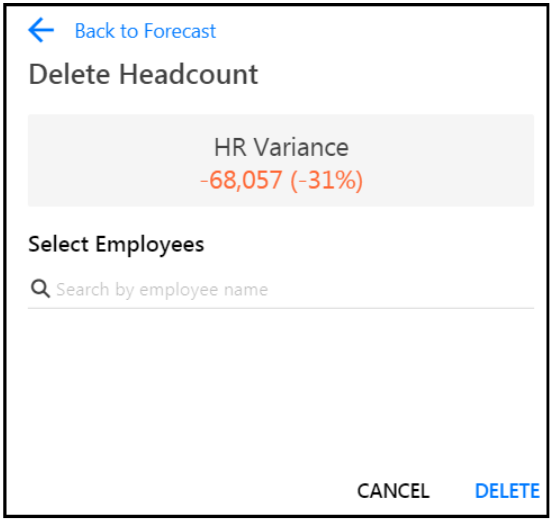
Select the employee you want to delete. The variance and impact to the account from which the employee will be deleted is provided as shown below.
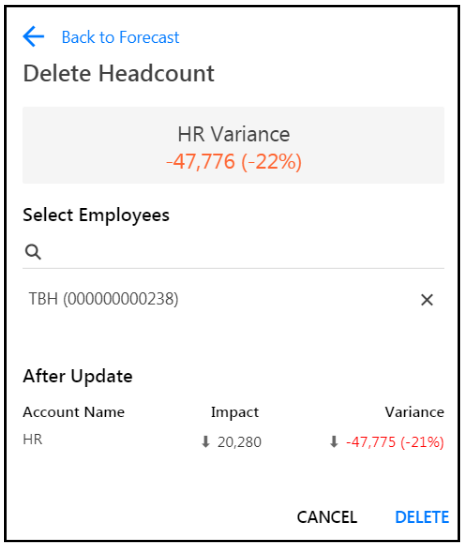
Click Delete.
On the MyPlan interface, click Submit. Once submitted, the updates take place in Workforce Planning templates.
How to Add an Asset
Click the Wrench icon for a Capital Planning account and select Add Asset. A pane opens on the right-hand side of the screen.
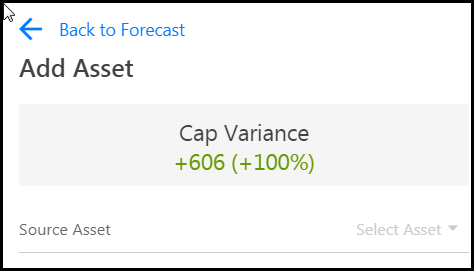
Select an asset type from the Source Asset list-box. Source Assets are used to help the user enter assets quickly. When you select a source asset, the additional attributes needed (from behind the scenes) to calculate depreciation are populated. For example, select Hardware if you’re purchasing a new laptop, and the system will automatically determine the asset's life to calculate the depreciation. Assets and Asset categories are created in the Capital Module by the administrator.
Select a Finance Mode (only necessary if you select an asset that is not yet budgeted for). Once selected, all fields appear in the pane (such as Purchase Month, Units, and Rate) as shown below.
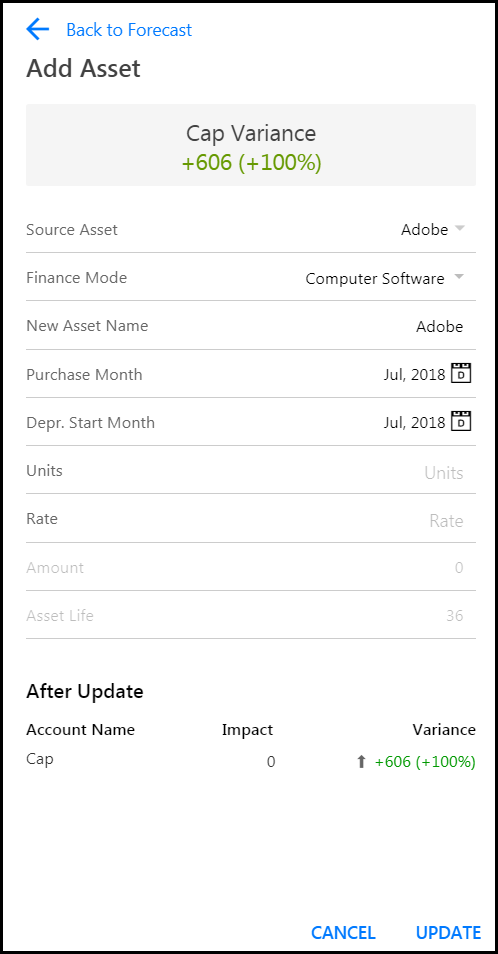
Enter the name of the asset in the New Asset Name field. For example, EliteBook laptop.
The remaining fields available for input in the example above may not be the fields available in your application. The fields available are established by your administrator during Capital Planning configuration. Input information for remaining fields based on your application and click UPDATE.
How to Add an Asset Not Yet Budgeted
Add assets that are not based on source assets. When situations occur where there are no source assets (for example, when new budget entities are created or assets are not set up) you can add assets that are not yet budgeted for from the MyPlan interface.
From the MyPlan interface, click the Wrench icon as shown below for a Capital account.
Select Add Asset.
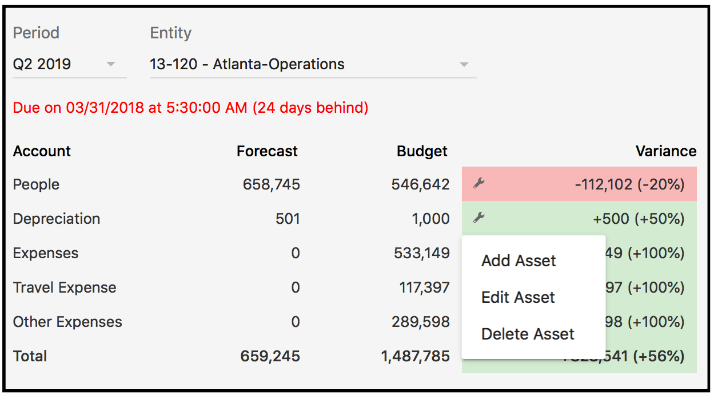
The Add Asset pane appears. Search for the asset by name. Type ahead functionality displays a list of available assets as you type. The list is grouped to show budgeted assets and assets not yet budgeted separately.
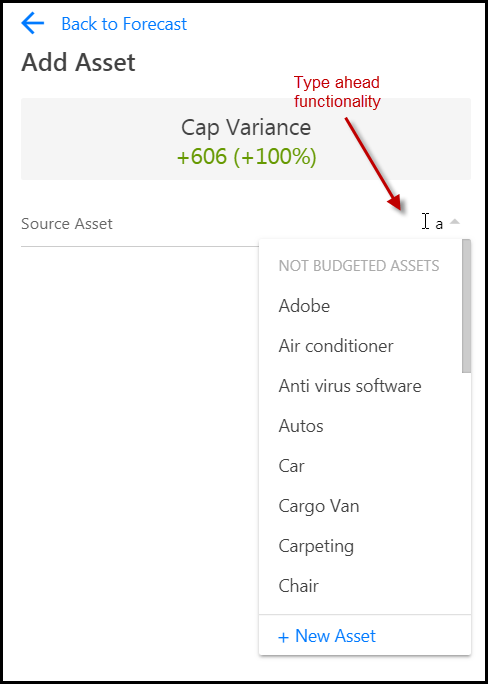
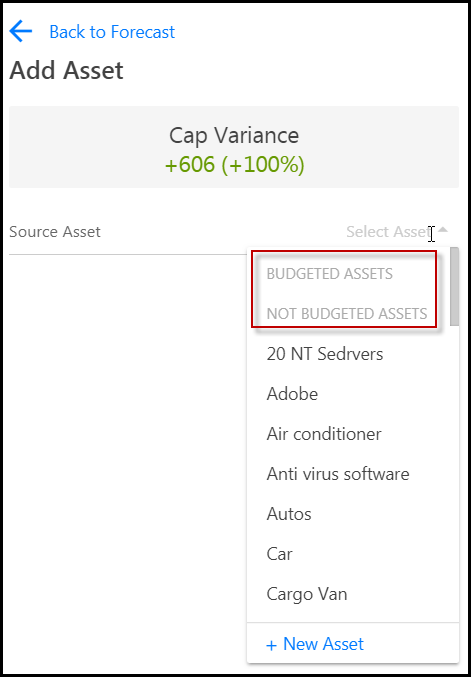
Select the source asset in which you want to base the new asset off from the NOT BUDGETED ASSET list.
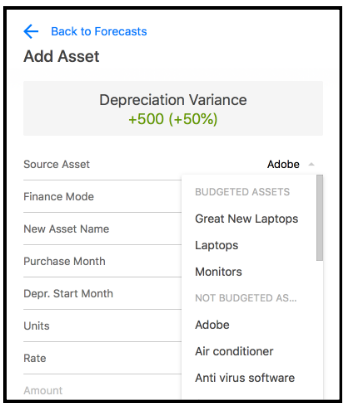
If you select an asset not yet budgeted for, then you must select the Finance Mode associated with the asset as shown below.
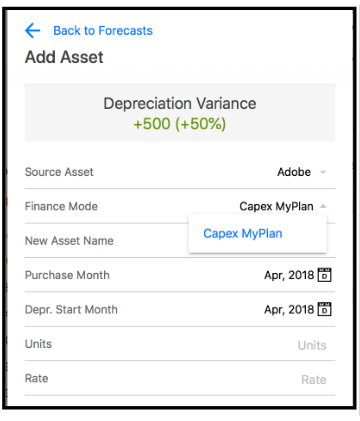
Complete remaining fields.
Click Update.
Click the Activity Manager icon, the newly added asset is shown. If you want to change parameters or adjust the asset that was just added, navigate back to the dashboard, click Edit and the Edit Asset screen will appear where you can further edit the asset details, or, click Revert in the Activity Manager, to reverse the addition of the asset.
How to Add An Asset for a Budget Entity When the Asset Definition Does Not Exist
Add an asset for a budget entity when the asset definition does not exist. This is a quick alternative to accessing Advanced Planning and adding the asset there.
In MyPlan, click the Wrench icon and select Add Asset for a Capex account.
Click the Select Asset list-box.
Click the+ New Asset link shown below.
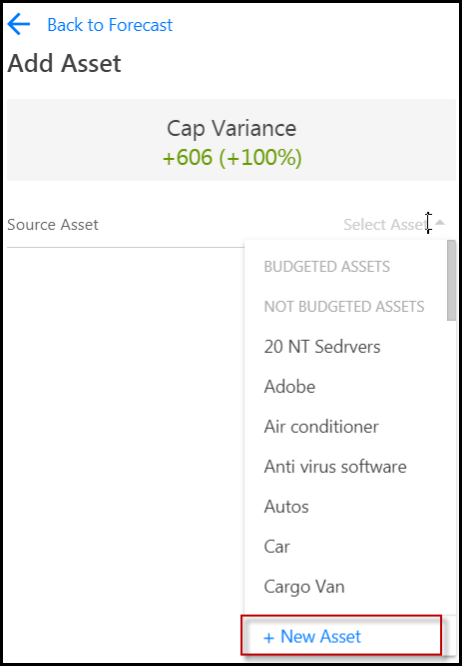
- The New Asset screen appears (shown below). Select any existing asset category in which you want to create the new asset.
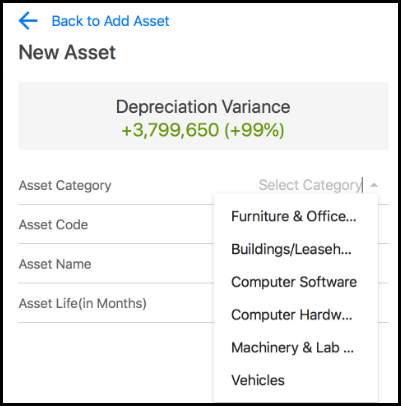
Enter the Code and Name of the Asset. Asset life defaults from the category selected.
Click Add, you will see the screen adjust to show the finance mode.
Select the Finance Mode.
Enter the Purchase Month, Units and Rate.
Next, select Update.
How to Edit an Asset
Edit assets from the MyPlan interface. All edits performed in MyPlan are automatically updated in the Planning application.
From the MyPlan interface, click the Wrench icon as shown below for a Capital account.
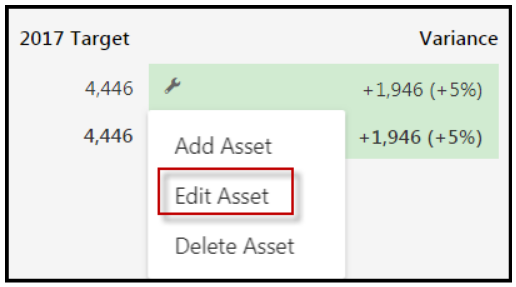
Select Edit Asset.
The Edit Asset pane appears. Select the asset you want to edit by selecting the Source Asset.
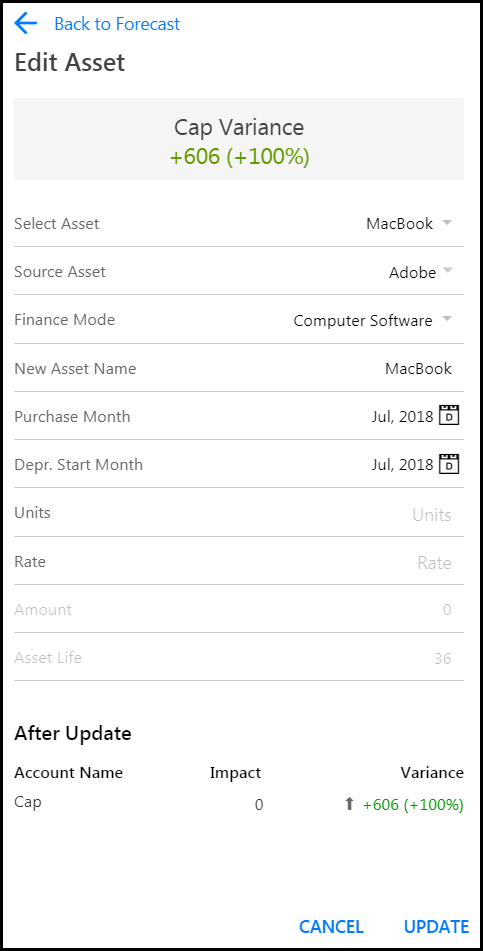
Adjust the purchase month, depreciation start month, number of units, rate, and asset life as needed. Amount is updated based on unit and rate changes.
Click outside of the cell updated. The After Update impact and variance is displayed.
Click Update. Return to the Forecast/Plan and click Submit for the section in which the Capital account was updated. Once submitted, the update takes place in CAPEX Planning templates.
How to Update an Account
When you update an account, for example update travel expenses or marketing costs, the related template is opened. In the example below, Adjust Expenses is selected for the Expenses account.
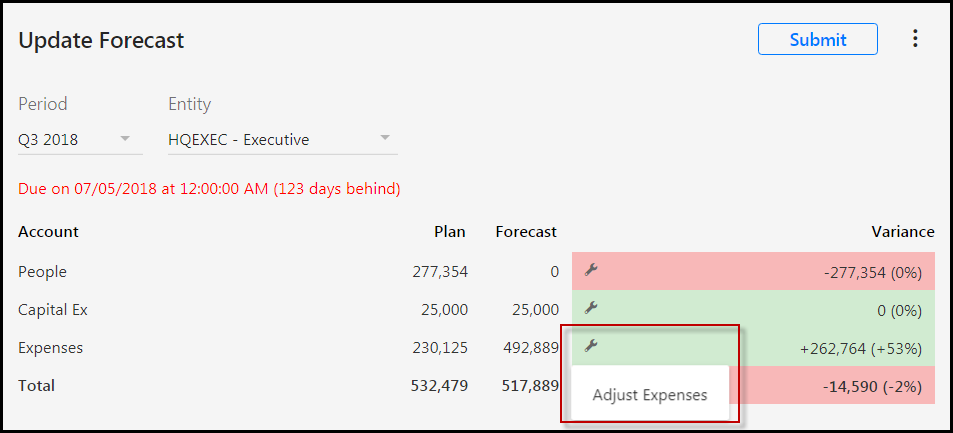
As a result of selecting Adjust Expenses , the related template is opened as shown below.
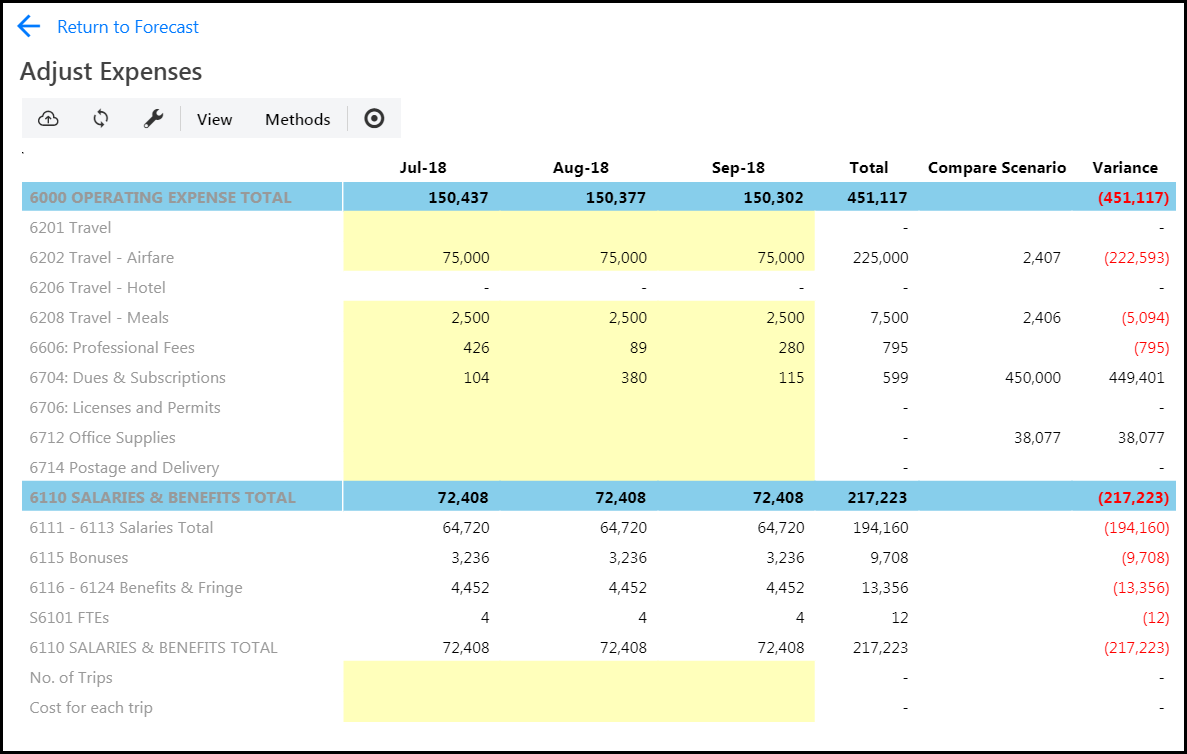
Notice the Compare Scenario column. Compare scenarios display comparative data from other scenarios such as: historical actuals, latest budget data, data from the prior budget cycle, and plans with budget targets.
You can perform template input to update the template by entering data in the yellow shaded cells shown below. The cells with a white background indicate that the period is closed for editing.
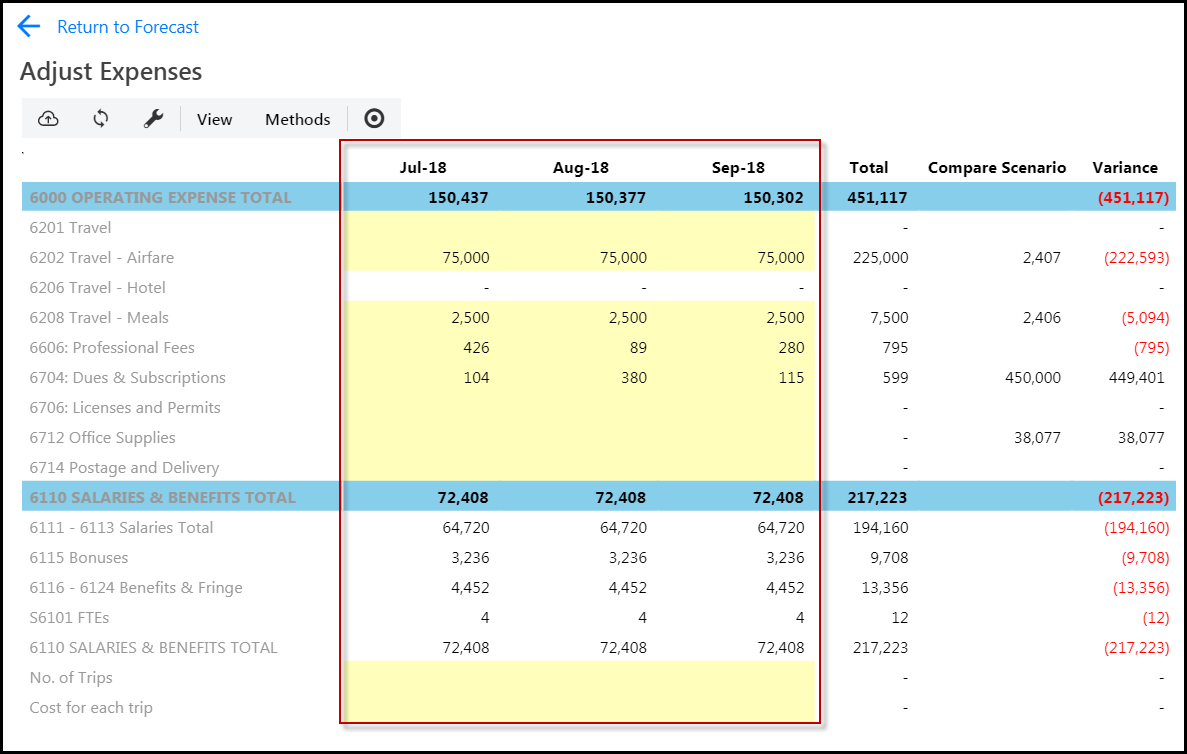
In the example below, the cells under Jul-18, Aug-18 and Sep-18 can be updated. As you update the yellow shaded cells, the Variance is automatically updated. You can’t update this column as it is for display based upon the data you enter in the yellow shaded fields.
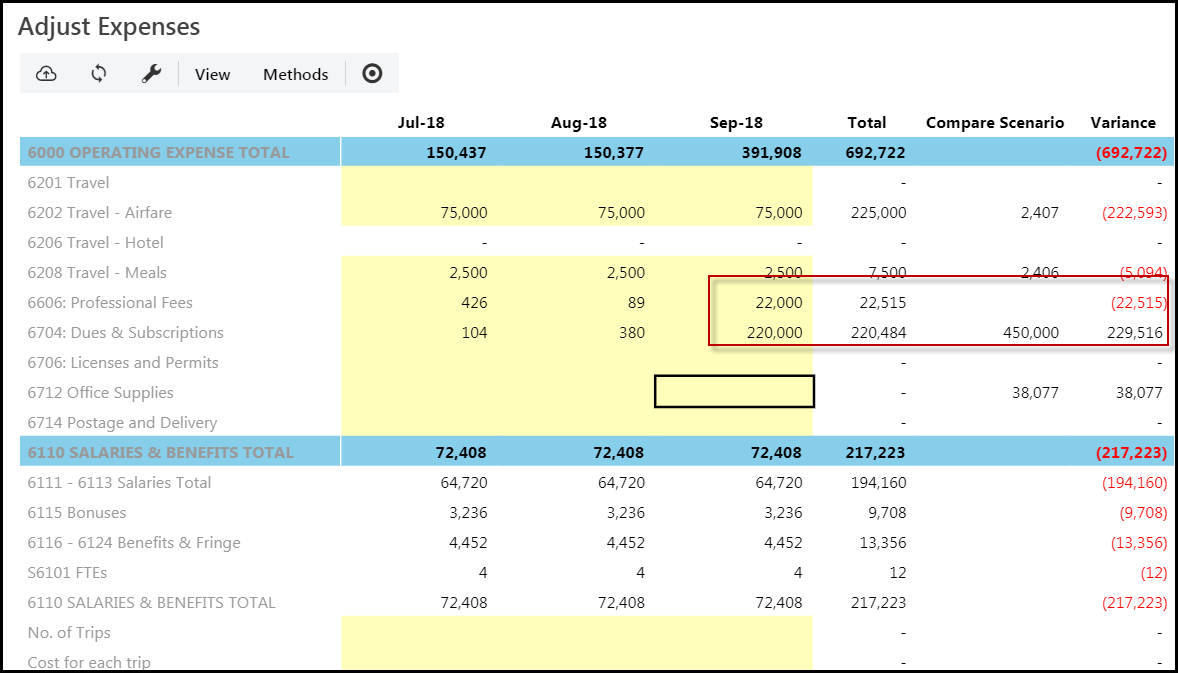
Once you update account data for open periods, click Update to commit template input/updates. For more detailed information on templates, see the Working with Templates in MyPlan topic below.
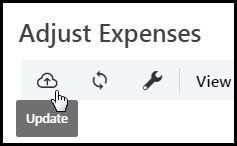
Working with Templates in MyPlan
Switching to Contributor Mode
In some cases, a contributor user might want to access a template opened in MyPlan in the Planning application. This option allows contributor users to enter data for the out periods (past 12 months), or use additional features available in the Planning application template version. To do so, select Open in Contributor Mode to access the template in Contributor mode.
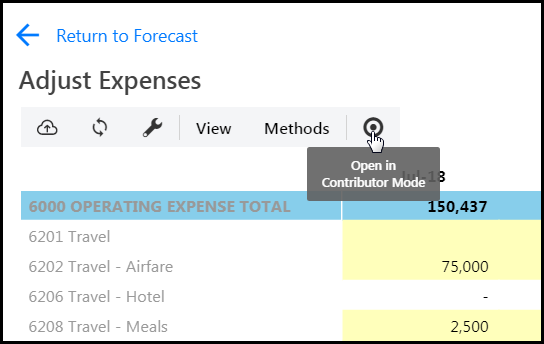
FIX IT
Fix It provides functionality to change the variance and apply the change to all open periods.
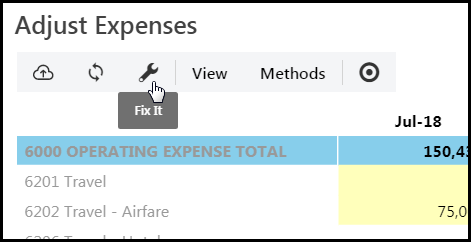
Click any cell on the row you want to fix. You can select multiple rows at once to fix. Press the Shift key and select multiple sequential rows. Or, press the Ctrl key to select multiple non-sequential rows.
Sequential rows selected:
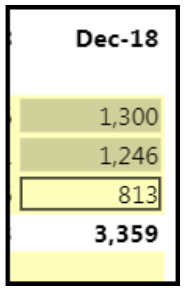
Non-sequential rows selected:
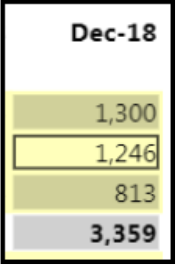
When you click Fix It, two options are displayed; Equally and Proportionally.
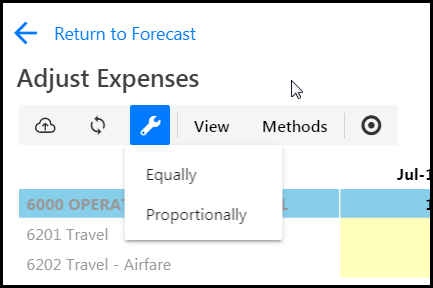
Fix It can be displayed, by either right clicking on a cell or by selecting the Fix IT button on the top of the page.
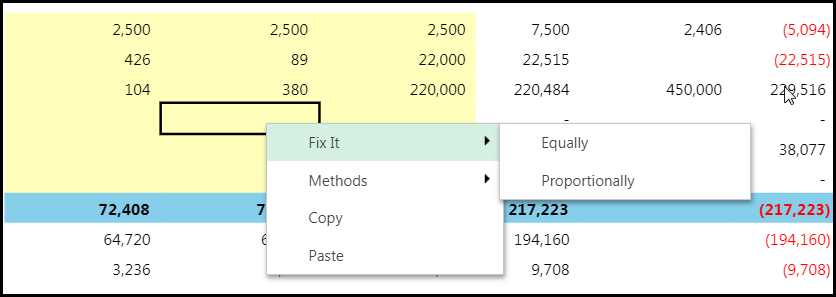
Fix It Equally
Selecting Equally, takes the amount in the Variance column and distributes it equally amongst the open periods. For example, using the template below, there is a variance of 90 dollars in the 3rd row. There are 3 open periods (Oct-18, Nov-18, and Dec-18) with a total amount for each period of 412 dollars.
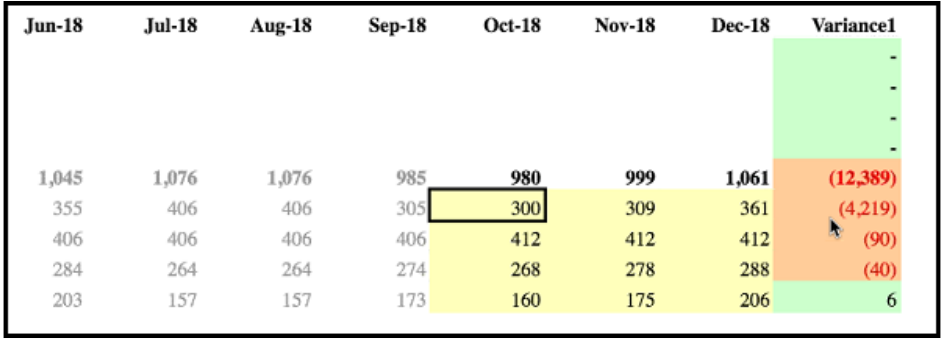
To make the variance 0 dollars, select the row and right click Fix It and select Equally . The 90 dollar variance is subtracted equally from the three open periods and the result is displayed below.
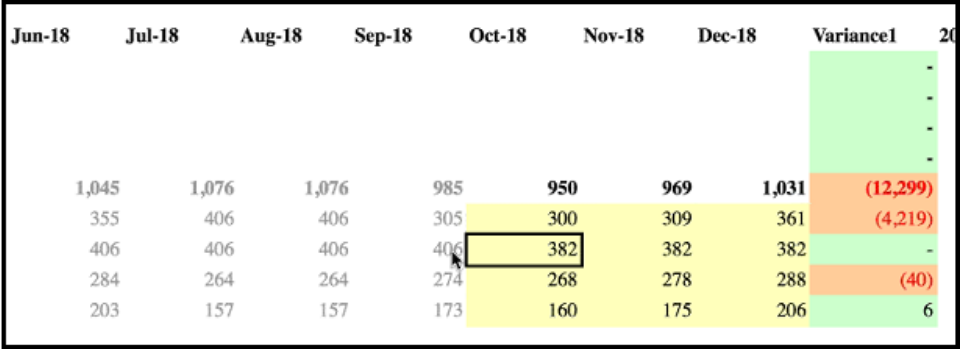
Fix It Proportionally
In this example, Oct-18 is 200, Nov-18 is 300 and Dec-18 is 400. The variance is 106 dollars, which is to be distributed proportionally to the three open periods. Click the row, then right click and select Fix It, Proportionally.
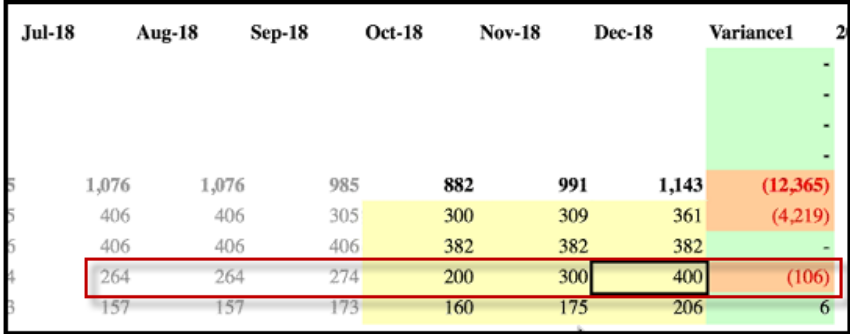
The result is that the same ratio of numbers in each period and adjusts the variance based on the ratio. The amount deducted for each period is proportional to the amount in the period. So, 24 is deducted from Oct-18, 35 is deducted from Nov-18, and 47 is deducted from Dec-18 as shown below.
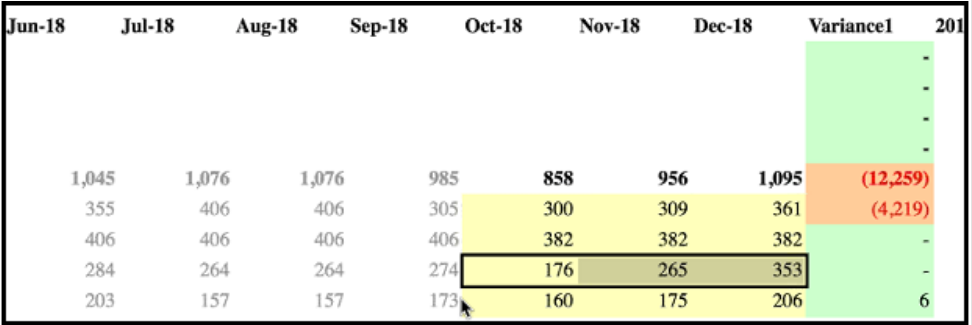
Methods
Methods allow you to spread data from a total column to period columns. The Methods option is displayed when you right-click in an editable cell in the template. Selections are made available based on how the template was set up by your Admin user. Options that might be available to you are shown in the image below and a description of each is provided below as well.
Monthly Increase in $ - Apply an increased dollar amount based on historical amounts for each month. Optionally, Round the number to the nearest whole number. For example; 67.7 will appear as 68. Click Apply.
Monthly Increase in % - Apply an increased percent based on historical amounts for each month. Optionally, Round the number to the nearest whole number. For example; 67.7 will appear as 68. Click Apply.
Full Year Growth - Apply a total increase percent based on history and use a spread method to distribute the amounts to the monthly periods. The spread method may be based on history or custom-defined spread methods created for the template. Optionally, Rounding the number to the nearest whole number. For example; 67.7 will appear as 68. Click Apply.
Clear Applied Method - Used to clear a previously applied method. Select a new method in the Methods pane shown below. When a method is applied, data in the cells is populated based on the method. When a user clears the method, the values are retained but the method logic underneath is removed on the row so that a new method can be applied.
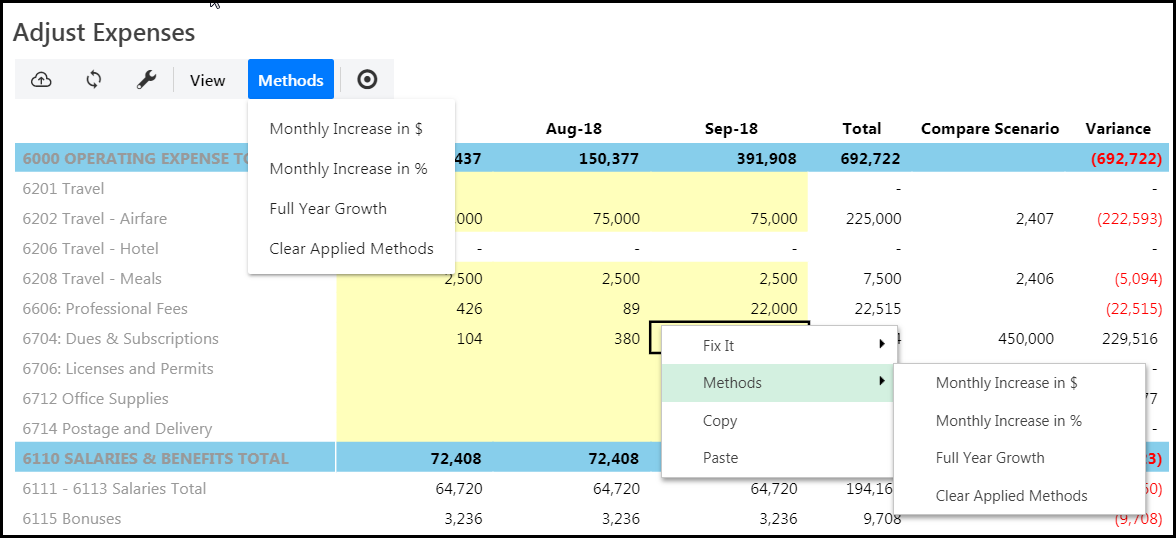
View
. For View, select from four options; Template Infobar, Formula Bar, Column Header and Row Header.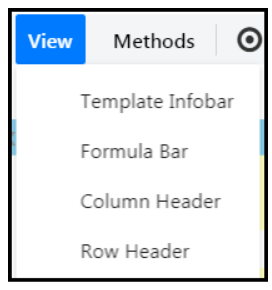
Selecting Template Infobar displays the Entity , Period and Template Name as shown below.

Selecting Formula Bar displays the fx bar where you can enter formulas such as SUM.
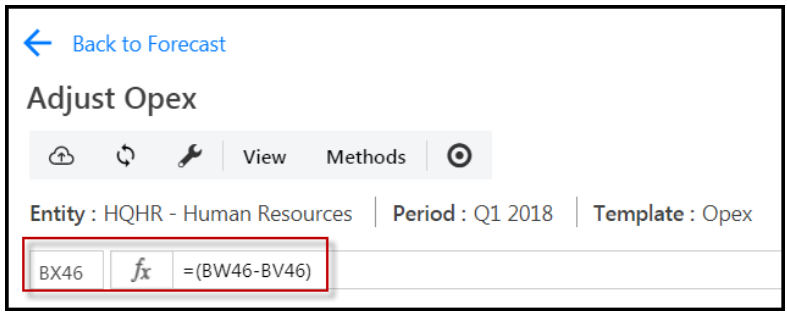
Select Column or Row Header to enable a more Excel like look and feel.
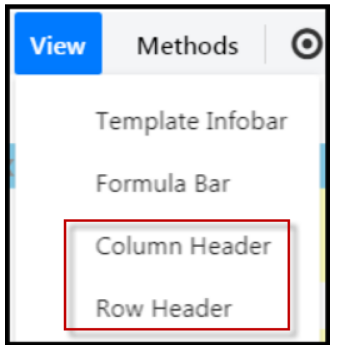
Activity Manager
Activity Manager provides a running list of all actions performed by users when the update button is selected. Access Activity Manager by clicking the icon shown below.
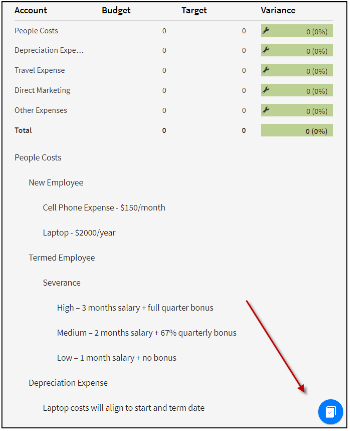
For example, if a user adds a headcount, the action along with the scenario affected, period, entity, the time/date the action was performed and a description of the action is displayed in Activity Manager. The user also has the ability to reverse or “Revert ” the actions they have performed, which is the true power of the Activity Manager.
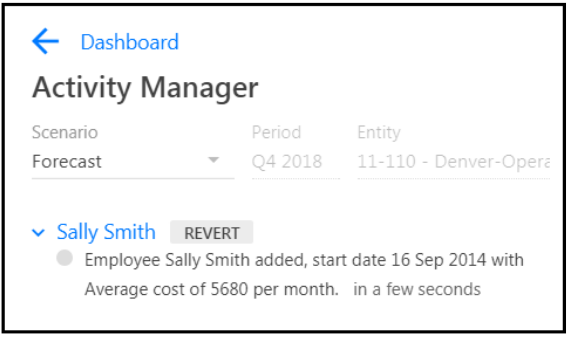
Once a user submits a budget or forecast or changes the time period and entity, the logs in Activity Manager for that entity/period are cleared as shown below. However, if you remain in the same period, but change the budget entity, the logs remain intact. Logs are only cleared when period and budget entity or period is changed. This is to preserve the data and calculations across years. In the next release all actions performed will be held until the user does a final submission. Activity Manager action items are pane specific. For example, if you submit a budget in pane 2, the activity log is cleared for that pane only. The activity log for panes 1 and 3 still exists.
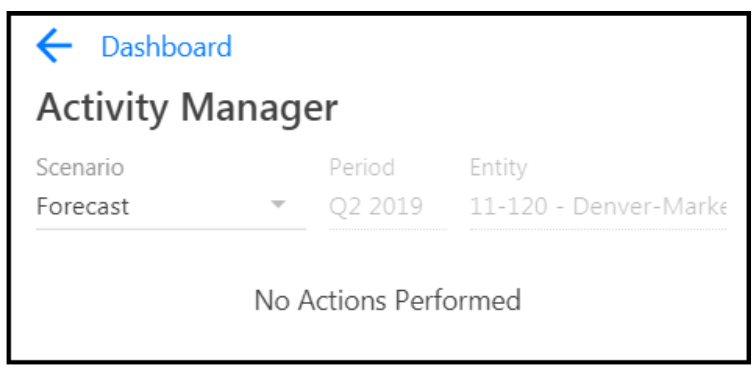
How to Submit a Budget/Forecast
In MyPlan, select the period and entity for which you want to submit a budget or forecast.
Ensure all updates are performed to the accounts available.
Click Submit. The follow message appears. Once the data is submitted, it is carried to the database and to the Planning application. Once submitted, the audit log actions in Activity Manager will be cleared for that period. As of now, MyPlan is not directly integrated with the Planning application workflow. With the next release this product will be fully integrated. Once a user submits a budget or forecast and they have completed their process, it is a best practice to email their boss (or approver) and notify them of this completion. This way the approver can manually forward the budget entity to start the workflow process.
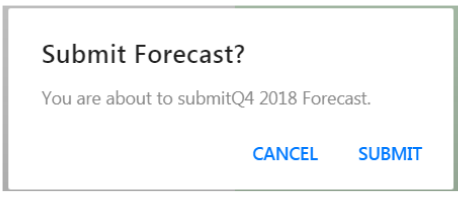
Click Submit.
Template Locking
Let's say you open budget entities when you have a MyPlan template opened, and then you decided to open another tab and template with the same budget entity combination in Advanced Planning as shown below. If this action was to take place, the MyPlan session continues, however, the newly opened template is placed into a locked state, which prevents input and also prevents other users from accessing that template and budget entity combination. The template will remain locked until the user that created the lock logs out of the application.
Limitations
When you have multiple tabs open (one tab open for MyPlan and another tab in Advanced Planning mode), changes made in Advanced mode will not reflect on the fly in MyPlan. Select the Switch to MyPlan option to reflect the changes.

